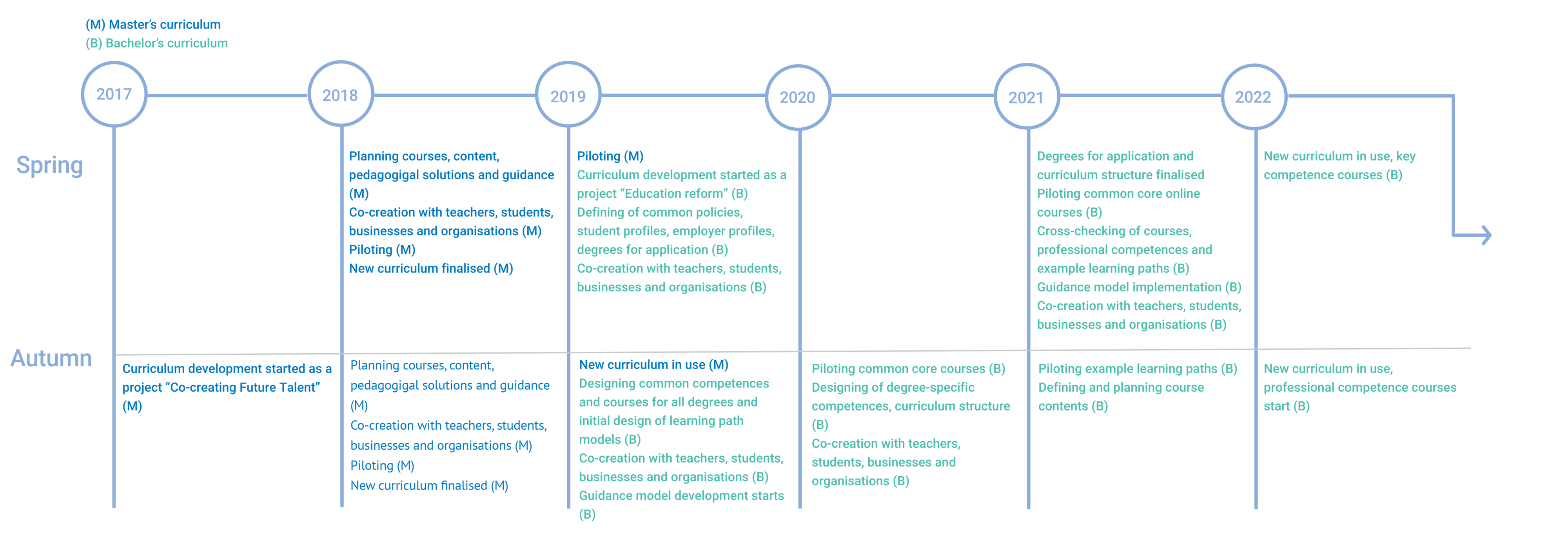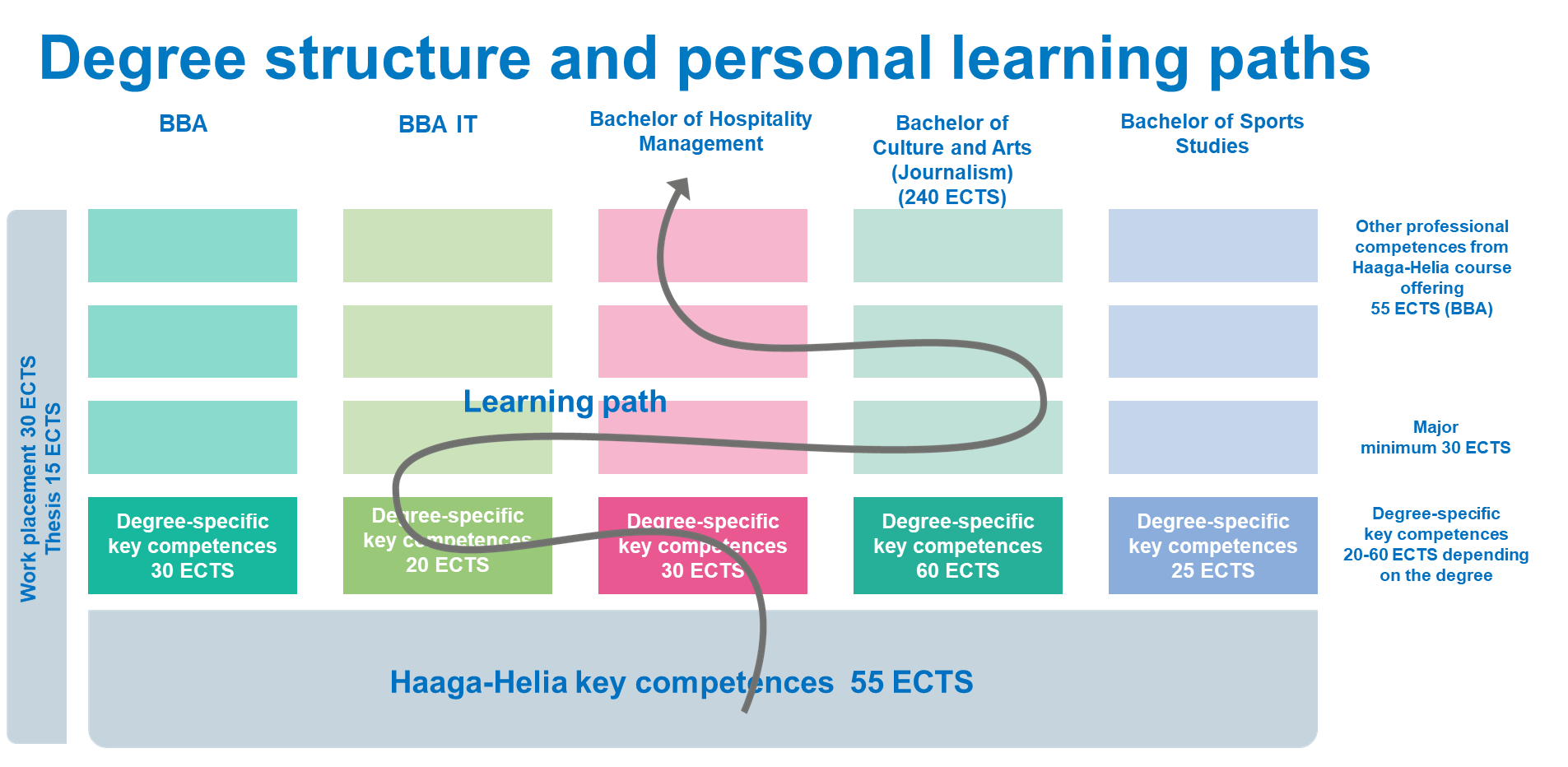Education reform as a joint development effort
The curricula renewal process has been a major enhancement activity in education. The result is still to be evaluated once also the bachelor level structure is in use at full capacity. The process is a good example of a joint development effort that has touched everyone, involving staff, students and stakeholders. Even though the Management Group has owned the process, the Haaga-Helia has been holistically involved in creating the change. Workshops, virtual discussions and discussions in different forums have enabled participation over organisational boundaries and ensured that the outcome will serve students, staff and other stakeholders comprehensively.

Picture 15. Education reform process
The new curricula are modular, giving students the possibility to choose studies more freely and build their own study path. The new curricula also recognise common Haaga-Helia key competences, and common courses have been built to give an equal starting point for all students. Moreover, the common studies for all degrees are built together ensuring the same workload, contents, and assessment in the courses. The new curricula have generated more collaboration among teachers and created new joint processes, leading to enhanced quality.

Picture 16. Curriculum supports personal learning paths
In connection to the education reform, the study counselling guidance model has redefined the roles and responsibilities. The study counsellors’ roles, competence counselling teachers, and the “Keys to studies” course are practices that have been created and modified to accommodate the increased need of counselling arising from flexible personal study paths. Additionally, the orientation days have been co-created so the contents and information are equal in all degrees and on all campuses. The orientation also includes a workshop on RPL to help students understand the knowledge and skills they have retained earlier. The new organisational model supports education development in general by allocating teachers’ working hours specifically for education development.
Organisational structure promoting dialogue
The new organisation model has resulted in new forums, working groups and increased dialogue between degrees and competence areas. One forum created is OSTU, in which degree, competence and research area directors discuss and decide on matters relating to education. Smaller working groups bring items to OSTU for discussion and decisions. For example, the RESU-group prepares issues related to teacher’s work time allocations to ensure equal practices at different campuses and degrees. The joint forum checks that joint processes and regulations are in place and together ensures the development of education.
New ideas, tools and collaborations
Teachers are encouraged to collaborate with each other, as well as with RDI and our various stakeholders. New learning environments have been actively developed and gathered under the concept of OPTI environments. We embrace new ideas and tools for teaching, to keep our education up to date and connected with industries.
For example, our students are helping Haaga-Helia’s online library HH Finna to develop more user-friendly services. This is achieved through mystery shopping, implemented with our SalesLab’s iMotions tool and students acting as shoppers. Ad hoc customer interviews in the space itself are also used as a development tool. In the interviews, the customers’ space experience and wishes and needs for the premises have been clarified. Customers have also had the opportunity to respond to a space survey. Results have been utilised especially in the renovation of the Pasila library.
Another example is the Service School format open for all, where interested parties come together to discuss, build ideas into projects and start implementing them. Especially RDI and competence areas in service business work closely together in the related work packages and there are tight links to LAB8 OPTI environment. The Food&Travel project and the new luxury project are examples of the results, where actively and systematically teaching and RDI are combined.
Improved course feedback system
The course feedback system has been developed to better serve the needs of development, as well as making it easier for students to answer. Teachers are now able to choose and add questions to the questionnaire as they see fit. Also, the teacher feedback on feedback has been integrated in the feedback system. A pilot for gathering feedback on the thesis process has been done to increase the students’ possibilities to voice their opinion.
Mentors in digital pedagogy supporting teachers
In recent years, the number of online and virtual course implementations has increased. This has challenged our teachers to create new materials and acquire new tools and techniques in a very short time. To help with this challenge, we have created a mentoring model in digital pedagogy which we call ”digipeda mentors’ model”, offering peer support for utilising digital tools effectively.